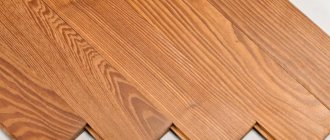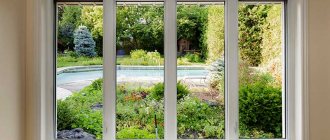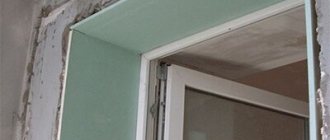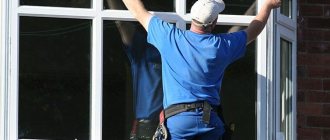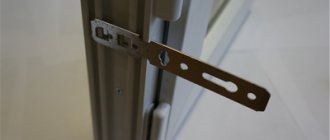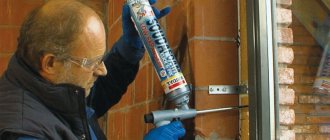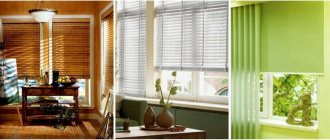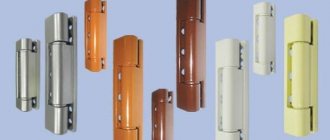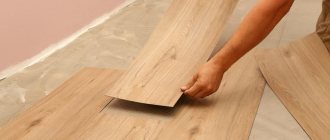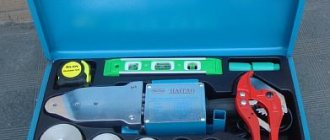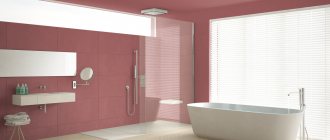The final stage of the process of installing modern windows is finishing the slopes. A thick profile, multi-chamber double-glazed windows and reliable fittings provide excellent thermal insulation, but the interface between the window frame and the apartment wall remains a cold and unattractive place. If this area is not given proper attention, condensation, mold, and wall destruction may occur. Therefore, let's find out which slopes are best suited for plastic windows.
What requirements must slopes meet?
Before considering window framing options, their advantages and disadvantages, let’s determine what is required of these elements.
Expert opinion
Anton Tsugunov
Construction expert. Entrepreneur. 17 years of experience. More than 100 completed objects.
Hello, friends!
First, I will talk about all types of slopes, as well as their pros and cons. I will describe the subtleties and share my experience. At the end of the article I will give recommendations on which slopes are the best choice, and in which cases one should give preference to one or another material and finishing method.
Important!
When applying for a slope installation service, be sure to enter into an agreement with electronic correspondence , then you can resolve all issues with the builders promptly and without headaches. Here is a link to my contract >>>
If you have problems with the quality of the slopes or with the timing of their installation, then you will need to write a claim. Here are samples of claims by deadline >>>
Enjoy reading!
Slopes should:
- Not inferior to the durability of the window design. Modern double-glazed windows are designed for a minimum of 15–20 years of operation. Slopes must withstand no less time without loss of basic qualities. Few people would like to redo them every two or three years.
- Comply with the general style of the window, forming a single whole with it.
- Maintain or even improve the performance characteristics of plastic windows.
- Withstand mechanical loads and impacts of the doors.
- If possible, be repairable.
What is it for?
Carrying out such work is relevant regardless of what project is being implemented. There are internal and external factors that can have a negative impact on windows and their overall service life:
- Mold and mildew, small insects.
- Sudden changes in temperature.
- Sunlight and wind, other types of precipitation.
- High indoor humidity.
- Condensation caused by the temperature difference between the outside and inside.
Proper finishing of internal slopes increases the overall service life of the window.
To prevent such problems, finishing of the slopes of plastic windows is necessary. With the right solution to the issue and a competent approach, resistance to environmental influences increases as much as possible.
Slope finishing options
When renovating an apartment in a new building or replacing windows, you will have to choose how to finish the openings after installing modern structures with double-glazed windows.
Window slopes can be finished using the following materials:
- plaster;
- drywall (gypsum plasterboard);
- gypsum fiber (GVL);
- plastic panels.
We recommend
Open type roller blinds.
Attaches directly to the frame, no drilling required.
Excellent protection from the sun and heat.
They don't take up space.
Many colors and sizes.
Price from 600 rubles for a complete set. Delivery is free from 3 days.
Lots of positive feedback. Verified seller! Read more >>>
Plaster slopes
The manufacturing technology consists of installing beacons, plaster corners and applying plaster. After drying, the slopes are puttied, sanded and painted. It is extremely difficult to do high-quality insulation, since the connection between the solution and the wall is lost.
Finishing a window opening with plaster has the following advantages:
- Versatility. This material is used in rooms with different humidity and temperature levels.
- Reasonable price. Plaster is an inexpensive material, and you can also save money by doing the work yourself.
- Strength. Plaster slopes are more resistant to mechanical stress compared to other types of finishing.
- No seams. Perhaps the main argument of supporters of such a coating is that there is no need to additionally process the joints and interfaces of the opening planes.
- Possibility of updating and repair.
USEFUL INFORMATION: Plastering window slopes with your own hands
But a number of serious shortcomings have led to the fact that plaster is used less and less for work of this kind:
- Duration and complexity of the process. Finishing takes considerable time: each layer of the plaster mixture needs to dry.
- A large amount of dust and dirt, risk of scratching the window.
- Low thermal insulation properties of plaster. Such slopes are prone to freezing in winter and condensation. In addition, when installing them, you have to cut the foam one or two centimeters inward, weakening the thermal insulation seam.
- Detachment from frame. It is impossible to firmly connect the plaster and the PVC frame. There are no sealants with equally good adhesion to both materials. This leads to the formation of cracks between the window block and the plaster layer.
USEFUL INFORMATION: Adjacent profile for window slopes
The last two drawbacks can be eliminated by insulating the opening with penoplex before plastering and using an adjacent window profile with reinforcing mesh.
USEFUL INFORMATION: How to putty the slopes on windows?
Expert opinion
Anton Tsugunov
Construction expert. Entrepreneur. 17 years of experience. More than 100 completed objects.
Today this is the dirtiest and longest finishing method. To avoid problems with condensation and mold, I recommend choosing this method only in warm rooms, for example, when a window is installed between a heated balcony and a living room, then freezing of the slopes is excluded. And also if there is simply no room left to install sheet material. For plastering warm slopes, I have been using Rotband plaster from Knauf . I buy it only from a trusted supplier.
This is better than going to the store, standing in lines first at the checkout, and then at checkout. The mixture is delivered to me directly to the site at the agreed time. It’s more convenient and safer!
Drywall slopes
To make them, pieces of gypsum board of the required size are used, which are screwed to a profile frame or glued to the sides of the opening. Then the surface of the drywall is primed, puttied and painted. In the case of laminated gypsum board, no further finishing is required. The space between the wall and the new slopes is insulated with polyurethane foam and insulation.
Attaching gypsum boards is easier and faster than creating a flat surface with plaster. But we must not forget that after installation, finishing is required, which will take several days. If you use laminated gypsum board, then the installation of the slopes is carried out in one day.
USEFUL INFORMATION: Drywall slopes: do-it-yourself installation
Advantages of using drywall:
- Low cost.
- Easy to install. Requires very basic construction skills.
- The ability to easily create perfectly smooth surfaces.
- Additional insulation.
- If preparation for staining and painting was carried out, then a simple repair, suitable for repeated repainting.
- If you use a good semi-gloss and gloss paint, you can wash the slopes many times.
- During finishing preparation and painting, it does not require the installation of plastic corners.
We recommend
Roller blinds of closed type.
Attaches directly to the frame, no drilling required.
Excellent protection from the sun and heat.
They don't take up space.
Many colors and sizes.
Price from 1,700 rubles for a complete set. Delivery is free from 3 days.
Lots of positive feedback. Verified seller! Read more >>>
USEFUL INFORMATION: How to putty the slopes on windows?
Flaws:
- Inability to firmly bind the slope material and the PVC frame (as with the plaster version). This leads to the appearance of cracks at the joints.
- Fear of moisture. If the windows “cry”, under the influence of condensation the drywall, even moisture-resistant, gradually collapses and swells near the frame. Regardless of whether the plasterboard is laminated or painted. Judging by the reviews, this is the main reason for refusing to use gypsum boards in the manufacture of slopes.
- Risk of sagging, dents and crushing. Still, drywall is a fairly fragile material.
To avoid the finishing stage, you can take laminated gypsum board instead of the usual one. But in this case, you will have to use special corners to cover the ends of the sheets.
Expert opinion
Anton Tsugunov
Construction expert. Entrepreneur. 17 years of experience. More than 100 completed objects.
I use moisture-resistant Knauf plasterboard with dimensions 2500x1200x9.5 mm . It is important to use smooth and dry sheets.
Shaping the Dawn Angle
In order for the plaster bevels to be strong and not crumble, especially external ones, you should not skimp on cement. The minimum proportion of its ratio with sand should correspond to 1 to 3, where 1 part of cement and 3 parts of pure sand, more is possible, but not less. Sand should be washed from river sand to avoid cracking. Before applying the solution, the wall surface must be moistened with water. For interior work, you can add a little alabaster to the mortar mixture. This solution turns out to be convenient for work, especially on the upper slope.
When plastering, be sure to maintain a small angle from the frame to the wall to preserve the openings of the window slopes. In this case, the angles of dawn should be the same.
The most difficult part is to plaster the uneven areas on the lintel of the upper slope. In this case, you need to plaster in several passes. In this case, the break should be until the thick layer has completely hardened. If necessary, you need to attach a masonry mesh to the lintel and plaster over it. When the solution is ready, you can begin plastering and shaping by applying the plaster mixture. To do this, apply the solution to the falcon and apply it to the wall with a trowel.
After this, we take the lath and apply it according to a certain angle of dawn to the wall so that the plate continuously slides along the lath when moving the square. We installed the slats using a level and plumb line. A rule is hung horizontally on top of the window openings and secured with nails or plaster dough. Plastering begins from the top. After we have plastered the upper slope, we take the rules and now hang them vertically on the sides of the slopes and plaster them. We level the solution applied to the bevels with a wide spatula, press it against the box and apply it to the attached rule.
Related article: Glass sink: advantages and selection criteria
After completing the upper slope, it is necessary to repeat plastering the surface of the side slopes in compliance with the specified angle of dawn. Internal slopes can be plastered with cement, cement-lime or gypsum mixtures with polymer fillers. When forming, for convenience, it is better to use gypsum mixtures, but it is better not to use them in their pure form.
Slopes made of gypsum fiber (GVL)
The technology for installing slopes made of gypsum fiber sheets is practically no different from attaching drywall, the advantages will be the same. At the same time, GVL does not have the disadvantages of GCR: it is much stronger and stiffer, and its moisture-resistant version is not at all afraid of a wet environment.
Expert opinion
Anton Tsugunov
Construction expert. Entrepreneur. 17 years of experience. More than 100 completed objects.
I believe that when installed correctly, gypsum fiber board slopes are superior to other options in terms of performance and appearance. But their use is justified only when finishing from scratch or during a major overhaul. Since during finishing it is necessary to install painting corners and putty not only the slopes, but also the adjacent wall.
USEFUL INFORMATION: GKL or GVL, which is better: differences, what is the difference, what to choose?
Advantages of gypsum fiber slopes:
- Fairly simple installation.
- High strength and rigidity.
- Possibility of high-quality insulation.
- Ideal design geometry.
- Long service life - more than 10 years.
- Maintainability: a damaged element can be easily puttied and tinted.
- Moisture resistance.
- The paint is easy to clean.
- Any decorative coverings can be mounted on GVL: from wallpaper to tiles.
Making a slope from gypsum fiber
GVL installation process
USEFUL INFORMATION: How to choose high-quality plastic windows and not overpay: professional advice
Flaws:
- Relatively high price (compared to gypsum board and plastic).
- The need for finishing.
- Cutting gypsum fiber is more difficult than cutting drywall.
If, after priming and puttying, you paint the GVL slopes with high-quality latex paint, then they can be washed without fear. And repainting will be required no earlier than after 5–8 years.
Background
In the old days, buildings were built with very thick brick walls and the windows resembled tunnels or narrow loopholes, like in fortress walls or towers. But in temples, to enhance illumination, the side walls were “pushed apart,” making the opening in the wall look like a megaphone.
The expansion angle reached 145. It came to be called the dawn angle, apparently from the first rays of sunlight entering the room.
The use of finishing technology taking into account the angle of dawn has become a tradition to increase the efficiency of using natural light.
Repair of slopes from GVL
In this case, the slopes were installed more than 8 years ago. During the process of cosmetic renovation (dividing the room into two parts), the slopes were partially puttied, sanded and painted. The work on the slopes took 2 days, the cost of the work is insignificant (compared to installing new slopes - even when compared with budget plastic ones). The walls were also painted, so no corners were needed.
An entire corner of the slope was missing. Crushed from being hit by a window for 8 years.
The slope has been completely restored and painted in 2 layers.
Expert opinion
Anton Tsugunov
Construction expert. Entrepreneur. 17 years of experience. More than 100 completed objects.
I use moisture-resistant GVL Knauf-Supersheet with dimensions 10x2500x1200 mm. One sheet is enough for several windows. I order and pay with a card with 33% cashback .
Final stage
When one end of the slope is located at the plane of the wall, and the other is inserted into the profile at the window, we measure the distances between the wall and the slope. Insert a wooden lath or profile trim for drywall into the gap. After measuring the gap between the wall and the slope, it is removed, and a wooden strip is installed in place of the gap and secured with self-tapping screws.
Now you need to take glue and glue the mineral wool insulation to the walls of the slopes. Then we install the sheet in the designed position. We place one edge of it in the profile, and the other is adjacent to a wooden batten and screwed with self-tapping screws in increments of 250 mm. We install the other side slope in the same way. We measure the size of the window and cut out the upper slope. Just like for the side openings, you should now install insulation and slats. Now you can install the top. We join the outer corner of the plasterboard sheets. We insert the profile and putty. You can simply cover the joint with a plastic square and attach it with glue.
Plastic slopes
Another way to get aesthetic and reliable slopes is to cover the opening with double-sided sandwich panels. They have not only good thermal insulation properties, but also sufficient rigidity.
It is not recommended to use one-sided sandwich panels and decorative wall panels made of thin cellular plastic for finishing the window opening. They do not have the necessary strength, wear resistance and thermal insulation qualities. It is better to use special panels for making slopes.
USEFUL INFORMATION: Choosing the best window sill for plastic windows (prices)
Plastic finishing is gaining increasing popularity. The material of the slopes not only visually harmonizes with the window frame made of PVC, but is also securely fastened to it using special sealants. This method of finishing the opening has other advantages:
- Low price.
- A smooth surface that retains its properties for many years and does not require additional finishing or regular maintenance.
- No cracks or temperature changes due to the use of the same material from which the frame is made.
- Additional thermal insulation that strengthens the weak point of the window opening - the seam between the frame and the wall of the room.
- Fast installation. Plastic slopes are installed faster than plasterboard and especially plaster ones.
- Minimum amount of dirt and dust when facing with plastic.
- 100% moisture resistant.
- It is possible to replace part of the slope if damaged.
- The frame covering the outer contour reliably protects the junction of the wallpaper and the window opening.
Minuses:
- Susceptibility to mechanical damage.
- Impossibility of local repairs. If it breaks, you will have to replace the entire panel.
- Low quality of additional elements, such as corners. Often these small parts are made from recycled plastic, which turns yellow over time and stands out unattractively against the background of snow-white slopes.
- Incompatible with interior. Glossy plastic will look unnatural in a room decorated in a classic style, as well as in any other design direction where natural materials are used.
USEFUL INFORMATION: Blinds on plastic windows: install them yourself
To avoid adding others to these disadvantages of plastic slopes, you need to choose the material wisely, guided by two main rules:
- Panels must be made from virgin plastic. Only such products are absolutely harmless even when heated in the sun and will not turn yellow after a year.
- The PVC layer must be thick enough. This will help avoid damage to the slopes.
When choosing between matte and glossy plastic, you need to take into account that stains and fingerprints are more visible on a glossy surface. Matte panels look more natural and are similar to classic painted slopes.
Glossy plastic
Matte plastic
Expert opinion
Anton Tsugunov
Construction expert. Entrepreneur. 17 years of experience. More than 100 completed objects.
Depending on the width and length of the slopes, I use different plastic slopes. Here are the common sizes:
Slope width 250 mm
Length 1.5 m - Insulated window slope 1500x250x10 mm
Length 2 m - Insulated window slope 2000x250x10 mm
Length 3 m - Insulated window slope 3000x250x10 mm
Slope width 400 mm
Length 1.5 m - Insulated window slope 1500x400x10 mm
Length 2 m - Insulated window slope 2000x400x10 mm
Length 3 m - Insulated window slope 3000x400x10 mm
Slope width 600 mm
Length 1.5 m - Insulated window slope 1500x600x10 mm
Length 2 m - Insulated window slope 2000x600x10 mm
Length 3 m - Insulated window slope 3000x600x10 mm
Platbands
Platbands or casing for internal slopes for PVC windows can be made of different materials, but its functional purpose is the same - protecting the installation seam from destruction and giving the window opening an aesthetic appearance.
Types of platbands
Platbands differ in appearance and functionality:
| Flat platbands. This is the easiest and most inexpensive type of cash withdrawal. | |
| Profiled platbands have a convex surface of different profiles, aimed at enhancing the decorative function of cashing. | |
| Shaped platbands can have a complex relief and imitate natural wood. | |
| Carved platband is the most expensive type of cash, made to order according to individual sizes. |
Materials for production
The most common material for making cash is sheet plastic. It is used for the manufacture of budget flat platbands, which can be used for finishing windows indoors and outdoors .
This material is not afraid of temperature changes, exposure to moisture or sunlight. Its surface can be laminated and take on any color or imitate various types of natural wood. Therefore, choosing cash to match the color of the window facade will not be difficult.
Plastic cash can be made to match any façade
Plastic platbands are not prone to deformation due to temperature changes and exposure to moisture.
Profiled PVC trims have the same properties, but may have a shaped surface. They are also used for interior and exterior window decoration.
MDF trims can also be flat or profiled, but they are used exclusively indoors, since the properties of MDF do not allow them to be used outdoors under the influence of surrounding natural phenomena.
For external use, dense foam casing can be used. This material is easy to process and install. The most intricate and complex shapes can be cut from polystyrene foam. It can be decorated with any finishing materials. It has negligible weight, so it does not put any load on the wall.
Foam trim can be used for exterior window decoration
The most expensive window design option is the installation of wooden carved cash. Carving can be done manually or mechanized. Handmade is very expensive due to its individuality and exclusivity.
Profiled and shaped platbands made of natural wood, made on a machine, will cost less.
Wooden platbands require careful care, since wood, when used in conditions of exposure to the external environment, has some disadvantages:
- wood can become deformed when absorbing moisture or crack as a result of drying out;
- Such cashing looks harmonious on wooden windows or on timber facades. On modern facades such cashing will look ridiculous.
Which slopes are best for plastic windows?
All slope finishing options have pros and cons. There is no ideal material that is better than others in every respect. Therefore, when choosing, you need to decide which properties and characteristics are more important in a particular case.
| Requirements for slopes | The most suitable material |
| Speed and ease of installation | Plastic |
| Durability | Plaster, gypsum fiber |
| Strength | Plaster, gypsum fiber |
| Moisture resistance | Plastic, gypsum fiber |
| Natural material, natural look | Plaster, drywall, gypsum fiber |
| Tightness of the structure | Plastic |
| Practicality, no need for maintenance and care | Plastic |
| Best maintainability | Plaster, gypsum fiber |
| Low price | Plastic |
| Original finishing options (decorative plaster, tiles, mosaic) | Plaster, drywall, gypsum fiber |
| No corners or visible frame elements | Plaster, drywall, gypsum fiber |
| Possibility to change the design | Plaster, drywall, gypsum fiber |
